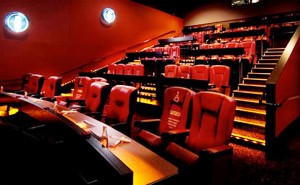 Movie theaters have been around for more than a century. The earliest theaters were converted storefronts where patrons paid a few cents to watch flickering films that were a few minutes long. When even these simple films drew crowds, moviemakers were inspired to develop better, longer films, and businessmen were inspired to develop better places to watch them.
Movie theaters have been around for more than a century. The earliest theaters were converted storefronts where patrons paid a few cents to watch flickering films that were a few minutes long. When even these simple films drew crowds, moviemakers were inspired to develop better, longer films, and businessmen were inspired to develop better places to watch them.
As projection techniques improved, theaters grew to accommodate larger crowds, and theater owners, which included movie studios themselves, embarked on a quest to make the movie-going experience more lavish and special. Movie theaters began to resemble stage theaters. There was almost a science to seating arrangements, with the rows of seats offset and built on a slight slope so people could see through and over the rows of patrons in front of them. Stadium seating, which actually dates back to the 1920s, became popular with the advent of the huge screens of the IMAX theaters in the 1970s. Theaters were some of the first commercial buildings to install air conditioning, making them even more attractive to patrons, especially in the summer months.
As the films became longer, theaters started offering drinks and snacks, and soon realized they could make more money with these offerings than with the actual movie tickets. Even though there was nothing special about the popcorn and sodas, patrons would pay the hugely marked-up prices. When ticket sales lagged in the 1980s, theaters responded by converting to multiple-screen layouts to draw more diverse crowds and adding more food choices such as hot dogs and pizzas.
Movie theaters regained their popularity. “Dinner and a movie” has long been a favored night out for adults. Some theaters obtained liquor licenses so they could offer adult beverages, but it wasn’t until the late 1990s that the true combination of dinner and movie was realized at the Alamo Drafthouse in Austin, Texas, where restaurant-quality food was delivered right to the patrons’ seats. The concept proved popular enough to franchise in 2003, but the idea didn’t really catch on until 2007, and hasn’t become widespread until the last couple of years. Patrons seem to like the “one-stop shopping” idea, especially when food quality is good and service is top-notch, making the experience feel special. Parents who are out for the evening, with or without kids, appreciate that the time required for dinner and a movie is cut in half.
As attractive as the idea is, it does present several challenges not found in typical movie theaters. Small snack bar areas must become much larger full kitchens. Theater seating must be modified to include tables and walkways for wait staff. That staff is the other biggest challenge: whereas typical multi-plexes can use the same small staff to clean multiple theaters, these full-service theaters must have multiple servers per theater, in addition to cooking staff. All this must be done without pricing tickets and services too high to attract large crowds.
The idea seems to be trending, though. Three years ago, these types of movie theaters accounted for roughly 7% of the roughly 5800 theaters in the country. Today, industry analysts estimate this figure has doubled, and even top players “in the business,” like Jeffrey Katzenburg, predict this is the future of movie-going. In this ever-evolving industry, it does seem to be the next generation.
Michael John Meisenbach

Recent Comments